
Couture pattern-making and sewing techniquesAmsterdam Fashion InstituteFashion & DesignYear 2Semester 4
- Subject:
- Architecture and Design
- Material Type:
- Module
- Author:
- Mirjam Ingram
- Date Added:
- 06/04/2023

Couture pattern-making and sewing techniquesAmsterdam Fashion InstituteFashion & DesignYear 2Semester 4

Basic pattern-making and sewing techniquesAmsterdam Fashion InstituteFashion & DesignYear 2Semester 4

Basic pattern-making and sewingAmsterdam Fashion InstituteFashion & DesignYear 2Semester 3
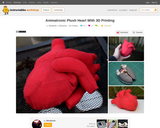
I wanted to make a realistic animatronic heart, and as I was developing the 3D printed mechanism I used a sock to try and get a vague idea of how the silicone skin would move once the design was finished. Since the silicone casting turned out to be quite challenging and very expensive, the sock test gave me the idea to instead use a slightly elastic fabric to make a plush heart design, which could be fitted over the 3D printed mechanism.
This project is very simple on the 3D printing/assembly/electronics side, but I'd recommend you have a little sewing experience because, as a sewing amateur, I'm not 100% confident in my patterns. A sewing machine is not necessarily required and a lot of the sewing is by hand anyway, but it would certainly be useful!
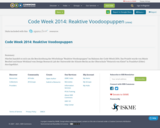
Hierbei handelt es sich um die Beschreibung des Workshops "Reaktive Voodoopuppen" im Rahmen der Code Week 2014.
Das Projekt wurde von Marie Beuthel und Anne Wohlauf vom Design Research Lab der Universität der Künste Berlin an der Oberschule "Heinrich von Kleist" in Frankfurt (Oder) durchgeführt.
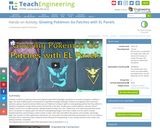
Students combine art, gaming culture and engineering by fabricating light-up patches to increase youngsters’ visibility at night. The open-ended project is presented as a hypothetical design challenge: Students are engineers who have been asked by a group of parents whose children go out Pokémon hunting at night to create glowing patches that they adhere to clothing or backpacks to help vehicle drivers see the kids in the dark. Student pairs create Pokémon character stencil designs cut from iron-on fabric patches, adding transparent layers for color. Placed over an EL (electroluminescent) panel that is connected to a battery pack, the stencils create glowing designs. Each team creates a circuit, which includes lengthening the EL panel wiring to make it easier to wear. Then they sew/adhere the patches onto hoodies, messenger bags, hats, pockets or other applications they dream up. The project concludes with team presentations as if to an audience of project clients. Keep the project simple by hand cutting and ironing/sewing, or use cutting machines, laser cutters and sewing machines, if available.

Video Tutorials to learn the basic hand stitches. Using the tutorials, the children can learn the basic hand stitches on their own as well as make beginning and finishing knots for their sewing projects. Contains 6 worksheets.

AMPD 1023
Welcome to Introduction to Apparel Production. Whether you are part of the college class or learning on your own, you will gain important concepts and techniques in beginning apparel production. This workbook is to accompany the activities through in person teaching or online learning. There will be graphics and videos to help guide you through each step of this workbook. There are 6 learning units and a sewing projects unit in this workbook. The sewing projects unit contains 4 projects: tote bag, skirt, shirt and pants. The pattern numbers may change due to the availability of patterns.
Word Count: 6704
(Note: This resource's metadata has been created automatically by reformatting and/or combining the information that the author initially provided as part of a bulk import process.)
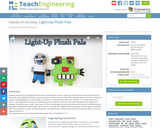
Students make their own design decisions about controlling the LEDs in a light-up, e-textile circuit, plush toy project that they make using LilyPad ProtoSnap components and conductive thread. They follow step-by-step instructions to assemble a product while applying their own creativity to customize it. They first learn about the switches—an on/off switch and a button—exploring these two ways of controlling the flow of electric current to LEDs and showing them the difference between closed and open circuits. Then they craft their creative light-up plush pals made from sewn and stuffed felt pieces (template provided) that include sewn electric circuits. Through this sewable electronics project, students gain a familiarity with microcontrollers, circuits, switches and LEDs—everyday items in today’s world and the components used in so many engineered devices.
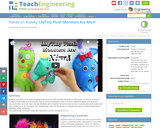
Students learn how to set up pre-programmed microcontroller units like the Arduino LilyPad and use them to enhance a product’s functionality and personality. They do this by making plush toys in monster shapes (template provided) with microcontrollers and LEDs sewn into the felt fabric with conductive thread to make circuits. At activity end, each student will have created his or her own plush toy, complete with LEDs that illuminate in a specified sequence: random twinkle, blink, heartbeat and/or breathing.
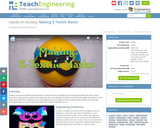
Students learn about engineering applications in artistic venues by designing and creating eye masks that each contain three LEDs. They explore parallel circuits with their LEDs, and sew with conductive thread to create light-up displays on their masks, gaining hands-on experience in using engineering technologies as well as custom product design and assembly.

Students apply sound-activated light-up EL wire to create personalized light-up clothing outfits. During the project, students become familiar with the components, code and logic to complete circuits and employ their imaginations to real-world applications of technology. Acting as if they are engineers, students are challenged to incorporate electroluminescent wire to regular clothing to make attention-getting safety clothing for joggers and cyclists. Luminescent EL wire stays cool, making it ideal to sew into wearable projects. They use the SparkFun sound detector and the EL sequencer circuit board to flash the EL wire to the rhythm of ambient sound, such as music, clapping, talking—or roadway traffic sounds! The combination of sensors, microcontrollers and EL wire enables a wide range of feedback and control options.

Students learn the functions of pre-programmed microcontroller units such as the LilyMini ProtoSnap as they use them to create light-up pennants with LED components. Students design their own felt pennants and sew on circuit components using conductive thread. This activity gives students hands-on experience with engineering technologies while making creative pennants with LED lights that can illuminate in three pre-programmed sequences: all on, breathing, and twinkle.
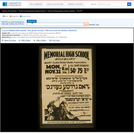
Poster for Federal Theatre Project presentation of "Dus Groise Gevins" at Memorial High School, Roxbury, Mass., showing three men sewing. Benefit: Boston Bicker Cholim Association.
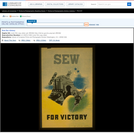
Poster promoting sewing as contribution to the war effort, showing outline of sewing machine with war images. Poster design by Pistchal.
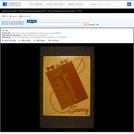
Poster promoting occupations related to sewing, such as power machine operator, alteration worker, dress designer, hand finisher, basting trimmer, packer, swatcher, showing a swatch of cloth with needle and thread. Date stamped on verso: Jun 20 1937.

When you live in wet and cold climates, survival becomes dependent upon how dry you can be. Ancestors and elders have passed on clothes-making traditions. Our host Dr. Lee Francis IV of Laguna Pueblo discusses ancient traditions involved in the making of waterproof clothing.